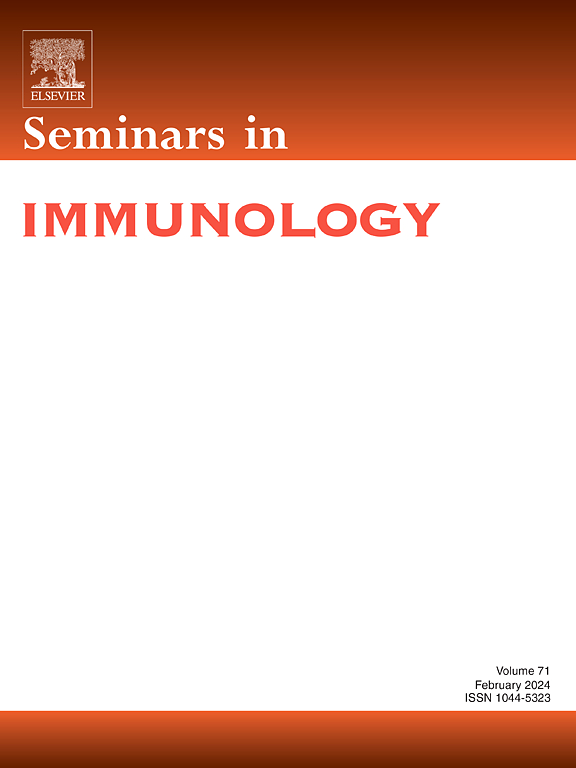应激和报警样细胞因子白介素-37介导的细胞外和细胞内信号通路
IF 7.4
2区 医学
Q1 IMMUNOLOGY
引用次数: 0
摘要
IL-37作为IL-1细胞因子家族的一员,被广泛认为是抑制先天和适应性免疫反应的关键免疫调节分子。这种细胞因子在不同的细胞外刺激下,在各种免疫和非免疫细胞中表现出组成性和可诱导的表达模式。在其五个已确定的异构体(a、b、c、d和e)中,IL-37b仍然是研究最全面的变体。来自小鼠模型的令人信服的实验证据表明,IL-37b在一系列病理条件下发挥保护作用,包括炎症性疾病、自身免疫性疾病、肿瘤过程和阿尔茨海默病(AD)。在人类中,IL-37作为炎症级联反应的天然调节剂,临床研究经常记录慢性炎症和自身免疫性疾病患者IL-37表达水平失调。IL-37b的抗炎机制主要通过双重途径介导:1)通过IL-18Rα受体复合物介导的细胞外信号传导,以及2)通过与信号分子如Smad3的直接相互作用介导的细胞内调节。我们的研究小组和其他人最近的进展已经阐明了IL-37d和IL-37a亚型的新生物学功能,并鉴定了以前未被识别的IL-37细胞内靶点,包括RAC1, C/EBPβ和Rheb。这篇全面的综述系统地检查了理解IL-37生物学功能的最新进展,特别强调了其在应激相关病理中的细胞内作用机制的新见解。本文章由计算机程序翻译,如有差异,请以英文原文为准。
The stress and the alarmin-like cytokine interleukin-37 mediated extracellular and intracellular signal pathways
IL-37, as a member of the IL-1 cytokine family, has been extensively characterized as a critical immunoregulatory molecule that suppresses both innate and adaptive immune responses. This cytokine demonstrates constitutive and inducible expression patterns across various immune and non-immune cells in response to diverse extracellular stimuli. Among its five identified isoforms (a, b, c, d, and e), IL-37b remains the most comprehensively studied variant. Compelling experimental evidence from murine models demonstrates that IL-37b exerts protective effects across a spectrum of pathological conditions, including inflammatory disorders, autoimmune diseases, neoplastic processes, and Alzheimer's disease (AD). In human, IL-37 serves as a natural modulator of inflammatory cascades with clinical studies frequently documenting dysregulated expression levels in patients with chronic inflammatory and autoimmune conditions. The anti-inflammatory mechanisms of IL-37b are primarily mediated through dual pathways: 1) extracellular signaling via the IL-18Rα receptor complex, and 2) intracellular modulation through direct interaction with signaling molecules such as Smad3. Recent advancements from our research group and others have elucidated novel biological functions for IL-37d and IL-37a isoforms and identified previously unrecognized intracellular targets of IL-37 including RAC1, C/EBPβ, and Rheb. This comprehensive review systematically examines current advancements in understanding IL-37's biological functions, with particular emphasis on emerging insights into its intracellular mechanisms of action in stress-associated pathologies.
求助全文
通过发布文献求助,成功后即可免费获取论文全文。
去求助
来源期刊

Seminars in Immunology
医学-免疫学
CiteScore
11.40
自引率
1.30%
发文量
50
审稿时长
89 days
期刊介绍:
Seminars in Immunology is a specialized review journal that serves as a valuable resource for scientists in the field of immunology. The journal's approach is thematic, with each issue dedicated to a specific topic of significant interest to immunologists. It covers a wide range of research areas, from the molecular and cellular foundations of the immune response to the potential for its manipulation, highlighting recent advancements in these areas.
Each thematic issue is curated by a guest editor, who is recognized as an expert in the field internationally. The content of each issue typically includes six to eight authoritative invited reviews, which delve into various aspects of the chosen topic. The goal of these reviews is to provide a comprehensive, coherent, and engaging overview of the subject matter, ensuring that the information is presented in a timely manner to maintain its relevance.
The journal's commitment to quality and timeliness is further supported by its inclusion in the Scopus database, which is a leading abstract and citation database of peer-reviewed literature. Being indexed in Scopus helps to ensure that the journal's content is accessible to a broad audience of researchers and professionals in immunology and related fields.
 求助内容:
求助内容: 应助结果提醒方式:
应助结果提醒方式:


